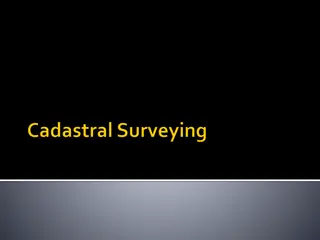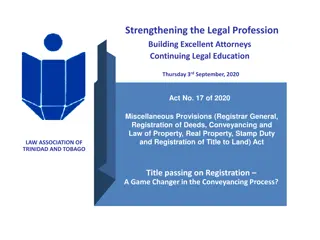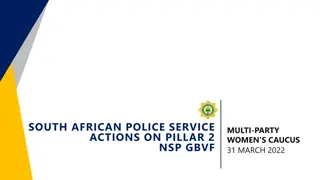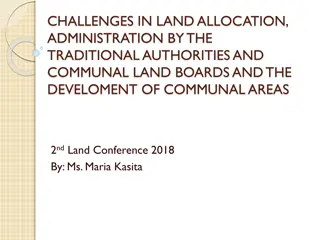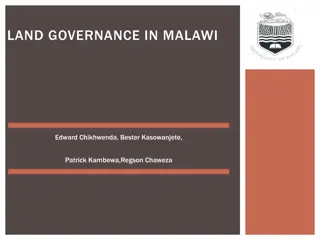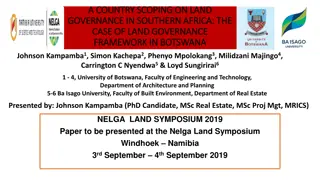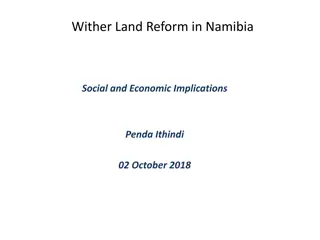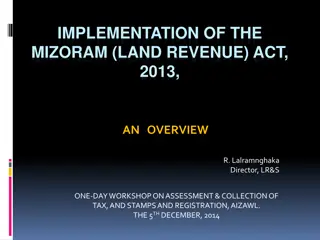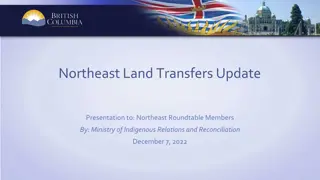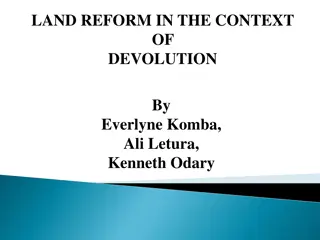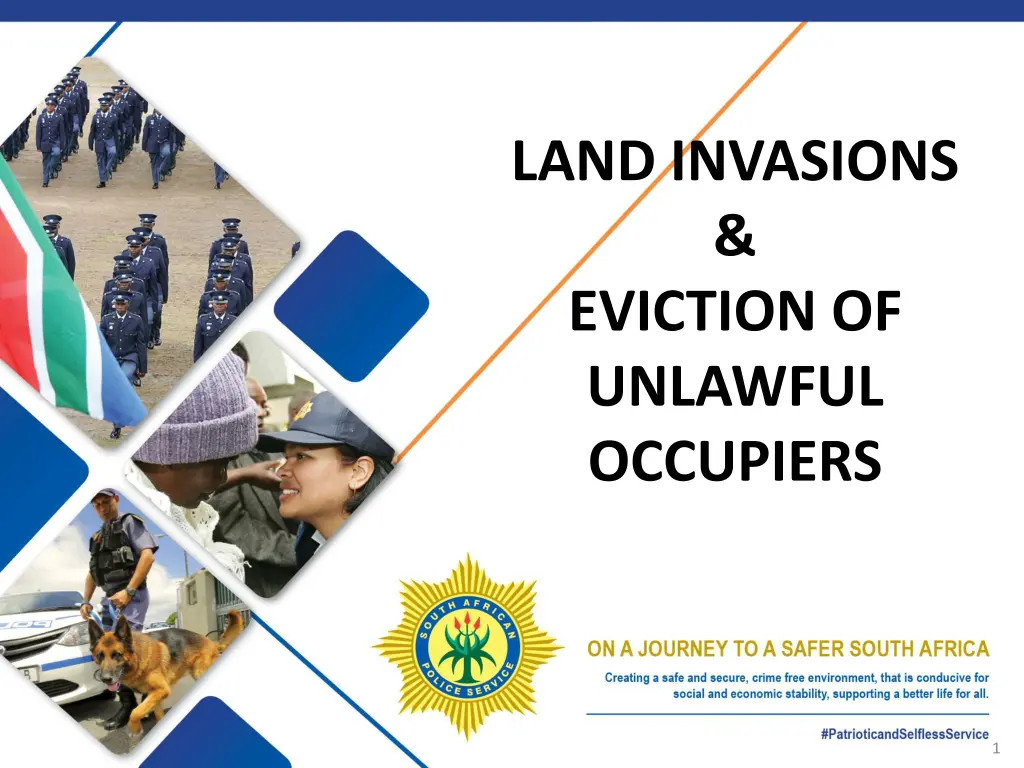
Unlawful Occupiers and Land Invasion Legal Framework
Explore the legal framework surrounding land invasions and eviction of unlawful occupiers, including relevant acts and instructions. Learn how to handle trespassing cases effectively to protect property rights.
Download Presentation

Please find below an Image/Link to download the presentation.
The content on the website is provided AS IS for your information and personal use only. It may not be sold, licensed, or shared on other websites without obtaining consent from the author. If you encounter any issues during the download, it is possible that the publisher has removed the file from their server.
You are allowed to download the files provided on this website for personal or commercial use, subject to the condition that they are used lawfully. All files are the property of their respective owners.
The content on the website is provided AS IS for your information and personal use only. It may not be sold, licensed, or shared on other websites without obtaining consent from the author.
E N D
Presentation Transcript
LAND INVASIONS & EVICTION OF UNLAWFUL OCCUPIERS 1
LAND INVASIONS & UNLAWFUL OCCUPIERS: INTRODUCTION Occupation of land by unlawful occupiers which is against the wishes of the owner of such property, is an issue often precipitated by socio-economic, socio-historic or socio- political factors. As such, the Service may be involved in matters of land invasions or evictions and must guard against overzealous or unlawful intervention. The Service is at risk not only regarding civil claims resulting from injury to persons or damage to property where members are involved, but also negative publicity and loss of public confidence. Land owners and occupiers must be requested to report incidents of land invasions and illegal evictions to their local police stations. 2
LAND INVASIONS & UNLAWFUL OCCUPIERS: LEGAL FRAMEWORK The legal framework within which policing of land invasions and evictions must occur is the following: Extension of Security Tenure Act 62 of 1997 [ ESTA ]; Land Reform Act 3 of 1996 (Labour Tenants) [ LTA ]; Prevention of Illegal Eviction from and Unlawful Occupation of Land Act 19 of 1998 [ PIEAct ]; Trespass Act 6 of 1959; Rental Housing Act 50 of 1999; Magistrates Court Act 32 of 1944; Rules regulating the Conduct of the Proceedings of the Magistrates Courts of South Africa (GNR.740 of 23 August 2010); 3
LAND INVASIONS & UNLAWFUL OCCUPIERS: LEGAL FRAMEWORK Sheriffs Act 90 of 1986; National Instruction 7 of 2017 Unlawful Occupation of Land and Evictions ; and National Instruction 4 of 2014 Public Order Police: Crowd Management during Public Gatherings and Demonstrations . 4
LAND INVASIONS & UNLAWFUL OCCUPIERS: REGISTERING OF TRESPASSING CASES Members are often approached by land/property owners who want to open a case of trespassing against a person who has erected a structure on his/her land/premises or who refuses to vacate structures on the land/premises. In these instances, members must determine whether the PIE Act, ESTA or LTA is applicable to the situation. If either of these three pieces of legislation is applicable, members must advise the complainant to consult with an attorney or to obtain legal advice in order to obtain the applicable eviction order against the illegal occupiers. 5
LAND INVASIONS & UNLAWFUL OCCUPIERS: REGISTERING OF TRESPASSING CASES If, however, a person/persons enters upon land or a premises without the permission of the owner/person in charge or without any lawful right to be on such land or such premises, the owner or person in charge may lay a charge of trespassing against such person/persons if he or she has informed them to leave the premises and they refused. Section 1 of the Trespass Act provides that any person who without the permission of the lawful occupier of any land or any building or part of a building; or of the owner or person in charge of any land or any building or part of a building that is not lawfully occupied by any person, enters or is upon such land or enters or is in such building or part of a building, will be guilty of an offence, unless he has lawful reason to enter or be upon such land or enter or be in such building or part of a building. 6
LAND INVASIONS & UNLAWFUL OCCUPIERS: REGISTERING OF TRESPASSING CASES Section 2(1) of the Trespass Act determines that: Any person convicted of an offence under section 1shall be liable to a fine not exceeding R2000 or to imprisonment for a period not exceeding two years or to both such fine and such imprisonment. Schedule 1 of the Criminal Procedure Act 51 of 1977, provides amongst other offences that: Any offence, , the punishment wherefor may be a period of imprisonment exceeding six months without the option of a fine , is a Schedule 1 offence. A PERSON WHO IS ENTITLED TO BE ON LAND IN TERMS OF THE ESTA , LTA OR PIE ACT IS DEEMED TO HAVE LAWFUL REASON TO ENTER AND BE UPON SUCH LAND. 7
LAND INVASIONS & UNLAWFUL OCCUPIERS: REGISTERING OF TRESPASSING CASES If it is clear to the land owner or owner of the premises in question, that the persons who are trespassing on the land or premises, are doing so with the intention to erect structures which accommodation (shacks, etc.), he/she may still lay a charge at the police for trespassing if such structures have not been erected yet. can be used for The SAPS may not refuse to register a case of trespassingwhen it is clear that there is no occupation yet on the land or premises. Even if the perpetrators are still in the process of erecting shacks or other structures, a case of trespassing can still be opened. 8
LAND INVASIONS & UNLAWFUL OCCUPIERS: REGISTERING OF TRESPASSING CASES The owner/person in charge of the property must lodge a formal complaint with the Service and provide an affidavit with the following information, for members to act: (i) the capacity of the complainant (whether he or she is the owner, lawful occupier or person in charge of the property in question); (ii) particulars of the suspect(s) who entered the property in question; (iii) whether the owner, lawful occupier or person in charge gave permission to the suspect(s) to enter the property in question or not; and (iv) whether the suspect(s) have any lawful reason for entering the property. 9
LAND INVASIONS & UNLAWFUL OCCUPIERS: REGISTERING OF TRESPASSING CASES Police officials should act immediately when a complaint is made that persons have entered upon land with the alleged intention of erecting structures to occupy the land in question. If time is wasted attending to the scene, it will allow the perpetrators time to erect structures, in which instance it will not amount to mere trespassing any longer. 10
LAND INVASIONS & UNLAWFUL OCCUPIERS: PIE ACT FOR PURPOSES OF THIS PRESENTATION WE ARE ONLY DISCUSSING THE RIGHTS OF AN UNLAWFUL OCCUPIER AS PROVIDED FOR BY THE PIE ACT. This category of occupiers will mostly be what is commonly known as squatters . As soon as a building or structure has been erected on land and is inhabited by a person (the person has factual control of the building or structure), the person is considered to reside on such land. A person in the process of erecting a building or structure and not inhabiting the building or structure is not residing on such land. Unlawful occupiers may only be evictedin terms of an order of the Magistrate s Court or High Court. Evictions outside the applicable legislation are illegal and the legislation provide for criminal offences, INCLUDING section 8(1) of PIE Act and section 23(1) of ESTA, which provide that eviction without a court order is an offence. 11
LAND INVASIONS & UNLAWFUL OCCUPIERS: PIE ACT Where the PIE Act refers to a building or structure it includes, but is not limited to a hut, shack, tent or similar structure or any other form of temporary or permanent dwelling or shelter. Where the PIE Act refers to consent , it means express or tacit consent, whether in writing or otherwise, of the owner of the land (or the person in charge) to the occupation by the occupier of the land in question. If a person start occupying property and the owner or person in charge allows this occupation unhindered, it may be construed as tacit consent. 12
LAND INVASIONS & UNLAWFUL OCCUPIERS: PIE ACT Once a structure has been erected and is ready for occupation, the owner of the land/premises must approach the court to apply for a court order in terms of the existing legislation, to evict the occupants. Members may not assist with the removal of structures or the physical eviction of unlawful occupiers. Only a sheriff and persons authorised by a court to assist the sheriff, may carry out an eviction order. When the sheriff anticipates any risk to his/her own safety and that of persons authorised to assist with an eviction, he/she may approach the relevant station commander to provide assistance, but only to secure him and such persons and to maintain law and during the eviction process. 13
LAND INVASIONS & UNLAWFUL OCCUPIERS: PIE ACT The PIE Act provides for procedures for the eviction of unlawful occupiers on all land, in urban and rural areas, whether owned by the State or a private person or institution. In terms of section 8(1), no person may evict an unlawful occupier except on the authority of an order of a competent court. Section 4 sets out the procedure for application for a court order for eviction of unlawful occupiers. The court must grant an order for eviction if it is satisfied that no valid defence has been raised by the unlawful occupier and determine in such order the date on which the eviction order may be carried out if the unlawful occupier has not vacated the land on a date determined in the court order. The court may order the demolition or destruction of buildings or structures that were occupied by such person. 14
LAND INVASIONS & UNLAWFUL OCCUPIERS: PIE ACT Although an eviction order must be executed by the sheriff, a court may authorise any person, such as members of the SAPS, to assist the sheriff to carry out the eviction of the unlawful occupier(s), and the demolition or removal of structures. Urgent proceedings for the eviction of unlawful occupiers may be instituted and the court may issue an interim eviction order, pending the outcome of proceedings for a final order, if there is an imminent danger of substantial injury to a person or damage to property or if the likely hardship to the land owner or other person exceeds the likely hardship to the unlawful occupiers. The period of illegal occupation must be considered by the court in order to establish whether the land owner must provide alternative accommodation for persons to be evicted. 15
LAND INVASIONS & UNLAWFUL OCCUPIERS: PIE ACT Offences in terms of the PIE Act: Apart from the offence in terms of section 8(1), mentioned above (evicting an unlawful occupier without a court order), the Act also creates the following offences: Section 3(1) determines that no person may receive or solicit payment of money or any other consideration for arranging or organising or permitting a person to occupy land without the consent of the land owner or person in charge of the land. Contravention of this section is an offence in terms of section 3(3). (note that a charge of fraud or corruption, depending on the circumstances, may also be registered together with this offence.) 16
LAND INVASIONS & UNLAWFUL OCCUPIERS: PIE ACT Offences in terms of the PIE Act: Section 8(2) states that no person may wilfully obstruct or interfere with an official in the employ of the State in the performance of his or her duties in terms of this Act. This will include the sheriff (and his or her appointed assistants) who executes the eviction order, and, where a court order instructs the SAPS to assist with the eviction, it will include police officials who act in terms of the court order. 17
LAND INVASIONS & UNLAWFUL OCCUPIERS: CASE LAW In Fisher and Another v Persons Unknown 2014(3) SA 129 (Western Cape High Court), the municipality demolished a number of informal structures that had been erected over the previous 2 days on their land, without first obtaining a court order under the PIE Act. The municipality argued that they were not bound to the provisions of PIE because it only applied to persons who occupied land in homes , and that the structures concerned could not be termed homes because- # they had not been on the land for a sufficient period of time; and # were vacant in the sense that they were not furnished and no persons were present at the time of demolition. 18
LAND INVASIONS & UNLAWFUL OCCUPIERS: CASE LAW The court held that: the question was not whether the temporary structures were homes, but rather whether those structures were occupied at the time when they were demolished. The court further stated that the PIE Act prevents that a person is deprived of the occupation of a building or structure on land, where such occupation had occurred without the consent of the owner or person in charge thereof. The court also noted that it was not so much the period of occupation of the property (two days), which rendered PIE applicable, but the intention behind the erection of the structures. Even the most humble structure, erected with basic materials, can be called a home by persons with limited means. 19
LAND INVASIONS & UNLAWFUL OCCUPIERS: CASE LAW All the structures in question were completed and the court stated that, the fact that a particular structure was vacant / empty at the time it was demolished, does not mean it was unoccupied: the occupant may have been at work, etc. The court concluded that, IF THE STRUCTURE WAS COMPLETE, THE INVASION OF THE PIECE OF LAND IN QUESTION HAD INDEED OCCUPATION HAD OCCURRED PROVISIONS OF PIE WERE APPLICABLE. TAKEN PLACE, THE AND 20
LAND INVASIONS & UNLAWFUL OCCUPIERS: CASE LAW In Stock and Others v Minister of Police and Others (Supreme Court of Appeal, 8 April 2019) the Court made certain findings in regard to the role of the SAPS in respect of illegal land invasions and the execution of eviction orders obtained by land-/property owners, against unlawful occupants The Court clearly stated that, if a land owner wants to take issue with the presence of a person on its land, he/she was obliged to lay a charge at the relevant police station or obtain a court order against such unlawful occupants. 21
LAND INVASIONS & UNLAWFUL OCCUPIERS: CASE LAW The Court continued to say that, it was not practical for SAPS to constantly monitor open spaces and try to curtail non-violent crimes such as trespass. The Court said that it was not the duty of the SAPS to evict unlawful occupiers, that is the responsibility of the Sheriff and the landowners, with the role of the police being merely to assist the Sheriff and the landowners with the eviction, in the event of the execution of a court order. 22
LAND INVASIONS & UNLAWFUL OCCUPIERS: CASE LAW It was also stated by the Court that it is not the duty of the SAPS to act as security guards for any particular property owner. The Court took note of several Court rulings which outlined the extent of the SAPS s powers and duties in regard to illegal land invasions and summarised these powers and duties as follows: SAPS is not responsible for evictions. That is the duty of the Sheriff. SAPS can merely assist with the maintenance of law and order during evictions and only pursuant to a valid court order; SAPS is not responsible for securing people s property. That is the duty of the landowner; 23
LAND INVASIONS & UNLAWFUL OCCUPIERS: CASE LAW SAPS has no obligation to prevent occupation of private propertyby homeless persons where it is not reasonable or practical to take preventative measures (for instance due to capacity constraints); SAPS should only arrest as a last resort. (Note: in the case of trespassing, an arrest can be executed to stop the offence from being committed if the person does not willingly remove himself from the property in question); SAPS cannot arrest all persons who are present on land without permission of the land owner in order to enable the land owner to obtain an eviction order. 24
LAND INVASIONS & UNLAWFUL OCCUPIERS: CASE LAW SAPS must ensure that any unlawful occupiers are treated with the dignity and respect during an eviction operation. (Note: persons who are being evicted may, where allowed by legislation, be arrested for the commission of offences committed during such operation, for instance assault of a Sheriff, hindering a Sheriff in the execution of his duties, assault of a police officer, etc.). In conclusion, the Court concurred with the finding of the High Court that it was unreasonable of the appellant to expect the SAPS to prevent people from moving onto large pieces of unfenced private property. The Court found that the appellants had hardly made any arrangements themselves to secure their property from being invaded by occupiers. 25
LAND INVASIONS & UNLAWFUL OCCUPIERS: CASE LAW CAN AN EVICTION ORDER BE OBTAINED AGAINST UNKNOWN OR FUTURE ILLEGAL OCCUPANTS? In the case of the Residents of Mooidraai Farm, Sasolburg v Metsimaholo Local Municipality, the Sheriff of the Free State and the South African Police Service, (case number 4902/2019), the Free State High Court, on 19 December 2019, considered an application made in October 2019, by the Municipality for the eviction of one S. Motjeane, the Economic Freedom Fighters (EFF) and potential unlawful occupiers of Mooidraai, Sasolburg. 26
LAND INVASIONS & UNLAWFUL OCCUPIERS: CASE LAW In this case, the Court stated the following: How would the court have been expected to implement the provisions of the (PIE) Act to persons and situations which were, as yet, not in existence or arisen? . The provisions of the PIE Act requires certain procedures to be carried out and certain factors in respect of unlawful occupiers to be taken into account before the court can issue an eviction order in terms of the Act. The Court also stated that a previous eviction order which was obtained in March 2017, cannot serve as notice, nor replace any of the requirements in section 4 of the PIE Act, as that order has been duly issued and executed and served it s purpose at that time. 27
LAND INVASIONS & UNLAWFUL OCCUPIERS: CASE LAW With regard to the 2019 application for an eviction order against future unlawful occupants, the Court stated that it would be improper to expect of the Court to take into account circumstances of unlawful occupiers who were not in occupation of the land at the time of consideration of the order, but only in the future. Therefore: An application for an eviction order in terms of the PIE Act, can only be brought against identified unlawful occupiers, at the time when the application is made and not against future unlawful occupiers. 28
LAND INVASIONS & UNLAWFUL OCCUPIERS: CASE LAW On 27 November 2020 the Constitutional Court of South Africa, in the matter of Economic Freedom Fighters (EFF) and Another v Minister of Justice and Correctional Services and Another, made an order declaring section 18(2)(b) of the Riotous Assemblies Act no.17 of 1956 to be inconsistent with section 16(1) of the Constitution and invalid to the extent that it criminalises the incitement of another to commit anyoffence . 29
LAND INVASIONS & UNLAWFUL OCCUPIERS: CASE LAW The Court suspended the operation of the above order for a period of 24 months from the handing down of the judgement, to enable Parliament to rectify the constitutional defect and ordered that section 18(2)(b) of the Riotous Assemblies Act should read as follows, until the defect has been rectified by Parliament: (2) Any person who (b) incites, instigates, commands, or procures any other person to commit, any SERIOUS offence, whether at common law or against a statute or a statutory regulation, shall be guilty of an offence and liable on conviction to the punishment to which a person convicted of actually committing that offence would be liable. 30
LAND INVASIONS & UNLAWFUL OCCUPIERS: CASE LAW The Constitutional Court inserted the word serious between any and offence , which has the effect that a person will only be guilty of incitement to commit an offence if the offence in question is a serious offence. Incitement, instigating or commanding a person to commit a less serious offence, will therefore no longer be criminalised by section 18(2)(b) of the Riotous Assemblies Act. The Constitutional Court refused the prayer by Mr. Julius Malema and the EFF for an order to declare that the Trespass Act 6 of 1959 does not apply to unlawful occupiers under the PIE Act. 31
LAND INVASIONS & UNLAWFUL OCCUPIERS: RESPONSIBILITY OF SAPS TO ASSIST THE SHERIFF Only a sheriff and persons authorised by a court to assist the sheriff may carry out an eviction order, provided that the sheriff must at all times be presentduring such eviction or actions authorised by the court (e.g. demolition and removal of buildings or structures), subject to the conditions as determined by the court. In situations where there is sufficient information to indicate that a sheriff and his or her employees may be exposed to injury, death or damage to property, members of the SAPS will be requested to assist the sheriff to enforce law and order, as well asto provide a protection service. 32
LAND INVASIONS & UNLAWFUL OCCUPIERS: RESPONSIBILITY OF SAPS TO ASSIST THE SHERIFF The sheriff may request assistance from the SAPS with the execution of a court order where that sheriff expects resistance. The following process should be followed: (a) The sheriff applies in writing to the Station Commander.The application must: (i) provide the date of execution of the court order; (ii) be accompanied by a copy of the court order; (iii) provide a brief description of the nature and extent of the assistance; and (iv) state reasons why assistance is needed and in the case of expected resistance, information available to the sheriff. 33
LAND INVASIONS & UNLAWFUL OCCUPIERS: RESPONSIBILITY OF SAPS TO ASSIST THE SHERIFF (b) The Station Commander must consider the application and decide whether assistance may be given in the light of: (i) the necessity demonstrated by the Sheriff; (ii) the available resources; (iii) threat assessment reports from Crime Intelligence; and (iv) weather conditions, such a rain, extreme cold, etc. (the sheriff must be informed that should adverse weather conditions exist on the particular day that assistance is required, he or she should wait for conditions to improve before assistance can be provided). (c) Where assistance is refused, full reasons must be provided and a copy of the refusal must be forwarded to the Office of the Provincial Commissioner. 34
LAND INVASIONS & UNLAWFUL OCCUPIERS: RESPONSIBILITY OF SAPS TO ASSIST THE SHERIFF The Station Commander must ensure that a written operational plan is drafted by the officer responsible for the operation and that full and proper records are kept of the event. Even if it is not expected that the assistance may involve the management of crowds, contained in National Instruction 4 of 2014 with regards to crowd management, should be applied for assistance in the planning phase. the planning principles In all cases where assistance is to be rendered, consideration must be given to request assistance from the relevant Public Order Policing Unit. 35
THANK YOU BRIG MK NALE 082 372 2094 NaleMK@saps.gov.za COL (ADV) JM (HANNES) DU PREEZ 082 771 8781 dupreezh4@saps.gov.za COL LEHANDRA LANE 082 455 6053 LaneL@gmail.com 36


